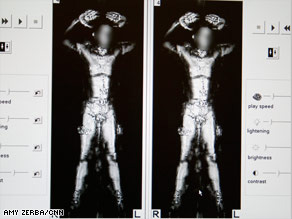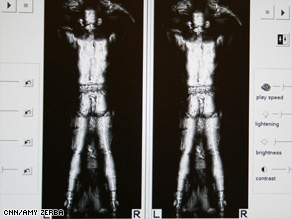
|  |  |  Travel & Outdoors | May 2009 Travel & Outdoors | May 2009  
Passengers, Advocates Up in Arms Over “Naked Picture” Airport Scanners
 Jason Mick - Daily Tech Jason Mick - Daily Tech
go to original


 | | Images of a TSA official taken using the new “full-body” scanner technology being piloted by the TSA. Note the anatomical features in the image, and the blurred face, which the TSA insists is enough to protect privacy. (TSA/CNN.com) | 
| | An image from a similar scanner, taken at a German airport. (Consumer Affairs) |  |
The scanners blur the face, but anatomy remains relatively visible.

Terrorism remains a significant concern and is a sensitive topic in the U.S. However, there are those who argue that some security efforts go a bit too far when it comes to protecting air travellers from attacks. Among such sensitive topics, none is drawing as much criticism and attention as the recently deployed “whole-body imaging” scanners.

The new scanner was first deployed in Phoenix, Arizona, in November 2007, and has since been deployed at 40 airports. The 40 deployed machines cost $170,000 each and provide an alternative to pat-down for customers repeatedly setting off the metal detector.

The system has its advantages — it is much faster than a pat-down search, taking only 15 to 30 seconds, where a pat-down search can take up to 3 to 4 minutes. The device also is touted as very safe, using millimeter wave technology, and emitting approximately 10,000 times less radio frequency than a cell phone.

However, the unsavory aspect to some is that the system reveals semi-nude images and anatomical features according to CNN. The image produced is milky white with the face and the skin blurred to protect the identity. Two officers work the scanner — one leads the passenger into it, and never sees the images; the other takes and examines the image, but never sees the passenger. The system is designed to provide extra protection to peoples’ identity.

Despite the presence of visible anatomical features, including male genitalia, Tulsa screener Debbie Shacklett states, “[The images] are not pornographic at all. I don’t look at them as people. I look at them as a thing that could have something on it.”

Lillie Coney, associate director of the Electronic Privacy Information Center, which is fighting the deployment, though, says they represent a grotesque invasion of privacy. She states, “People need to know what’s happening, with no sugar-coating and no spinning. We don’t have the policy to hold (the TSA) to what they say. They’re writing their own rule book at this point.”

She adds, “What they’re showing you now is a dumbed-down version of what this technology is capable of doing. Having blurry images shouldn’t blur the issue”

Rep. Jason Chaffetz (R-Utah) has introduced legislation to ban the machines. Like Ms. Coney, he is opposed to the scanners and the clearer “backscatter” technology scanners, which the TSA says it does not currently deploy.

Chris Calabrese, a lawyer with the American Civil Liberties Union comments on the issue, “A choice between being groped and being stripped, I don’t think we should pretend those are the only choices. People shouldn’t be humiliated by their government,” to satisfy security concerns.

The TSA says that the deployment is still in the pilot phase. However, officials say they say that they believe the program has been a success so far, and they hope to see it expanded to more airports. In the meantime, the issue of these blurred nude images seems unlikely to be unlikely to go away. |

 |
|  |



